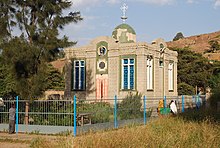
The Ark of the Covenant, also known as the Ark of the Testimony or the Ark of God, is believed to have been the most sacred religious relic of the Israelites. It is described as a wooden chest coated in pure gold and topped off by an elaborate golden lid known as the mercy seat. According to the Book of Exodus and First Book of Kings in the Hebrew Bible and the Old Testament, the Ark contained the Tablets of the Law, by which God delivered the Ten Commandments to Moses at Mount Sinai. According to the Book of Exodus, the Book of Numbers, and the Epistle to the Hebrews in the New Testament, it also contained Aaron's rod and a pot of manna.

Axum, also spelled Aksum, is a town in the Tigray Region of Ethiopia with a population of 66,900 residents. It is the site of the historic capital of the Aksumite Empire.

Frumentius was a Phoenician Christian missionary and the first bishop of Axum who brought Christianity to the Kingdom of Aksum. He is sometimes known by other names, such as Abuna and Aba Salama.

The Tigray Region, officially the Tigray National Regional State, is the northernmost regional state in Ethiopia. The Tigrai Region is the homeland of the Tigrayan (Tegaru), Irob people and Kunama people. Its capital and largest city is Mekelle. Tigray is the fifth-largest by area, the fourth-most populous, and the fifth-most densely populated of the 11 regional states.

Tabot is a replica of the Ark of the Covenant, and represents the presence of God, in Ethiopian Orthodox and Eritrean Orthodox Churches. Tabot may variously refer to an inscribed altar tablet, the chest in which this tablet is stored, or to the tablet and chest together.

The Tekezé or Täkkäze River, also spelled Takkaze, is a major river of Ethiopia. For part of its course it forms a section of the westernmost border of Ethiopia and Eritrea. The river is also known as the Setit as it joins the Nile tributary Atbara river just over the border in Sudan. According to materials published by the Ethiopian Central Statistical Agency, the Tekezé River is 608 kilometers (378 mi) long. The canyon which it has created is the deepest in Africa and one of the deepest in the world, at some points having a depth of over 2000 meters.

The Sign and the Seal: The Quest for the Lost Ark of the Covenant is a pseudoarchaeological 1992 book by British author Graham Hancock, in which the author describes his search for the Ark of the Covenant and proposes a theory of the ark's historical movements and current whereabouts. The book sold well but received negative reviews.

Tigray Province, also known as Tigre, was a historical province of northern Ethiopia that overlayed the present day Afar and Tigray regions. Akele Guzai borders with the Tigray province. It encompassed most of the territories of Tigrinya-speakers in Ethiopia. Tigray was separated from the northern Tigrinya speaking territories by the Mareb River, now serving as the state border to Eritrea, bordering Amhara region in the south.
Tana Qirqos is an island in the eastern part of Lake Tana in Ethiopia, near the mouth of the Gumara River, having a latitude and longitude of 11°51′49″N37°29′27″E. It is considered a holy island, and only monks of the Ethiopian Church live there.
The Book of Axum is the name accepted since the time of James Bruce in the latter part of the 18th century CE for a collection of documents from Saint Mary's Cathedral of Axum providing information on History of Ethiopia. The earliest parts of the collection date to the mid-15th century during the reign of Zar'a Ya`qob.
Edward Ullendorff was a British scholar of Semitic languages and Ethiopian studies.

Abuna Aregawi was a sixth-century Syrian monk and canonized by the Ethiopian Orthodox Tewahedo Church, as well as by the Ethiopian Catholic Church, as well as the Eritrean Orthodox Church. He is one of the Nine Saints, who came from the Roman Empire to Ethiopia, and are credited for founding many monasteries and churches and was the main force behind installing monasticism in Ethiopia.
The provinces of Eritrea existed since pre-Axumite times and became administrative provinces from Eritrea's incorporation as a colony of Italy until the conversion of the provinces into administrative regions. Many of the provinces had their own local laws since the 13th century.
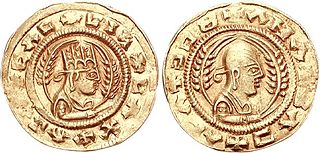
The Kingdom of Aksum also known as the Kingdom of Axum, or the Aksumite Empire, was a kingdom in East Africa and South Arabia from classical antiquity to the Middle Ages. Based in what is now northern Ethiopia and Eritrea, and spanning present-day Djibouti and Sudan, it extended at its height into much of South Arabia during the reign of Kaleb of Axum.
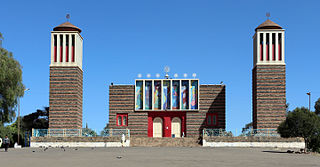
Enda Mariam Cathedral is an Eritrean Orthodox church in Asmara, Eritrea. The cathedral is located on Arbate Asmara Street.
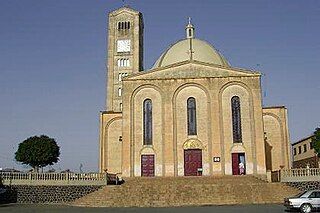
Kidane Mehret Cathedral is a Catholic church located on Adi Quala Street, Asmara, Eritrea. The cathedral belongs to Eritrean Catholic Archeparchy of Asmara.
Events of 2020 in Ethiopia.

The Axum massacre was a massacre of about 100–800 civilians that took place in Axum during the Tigray War. The main part of the massacre occurred on the afternoon and evening of 28 November 2020, continuing on 29 November, with smaller numbers of extrajudicial killings taking place earlier, starting from 19 November and during the weeks following the 28–29 November weekend. The massacre was attributed to the Eritrean Defence Forces (EDF) by Amnesty International, Associated Press, the Ethiopian Human Rights Commission (EHRC), Human Rights Watch (HRW) and Adigrat University lecturer Getu Mak.
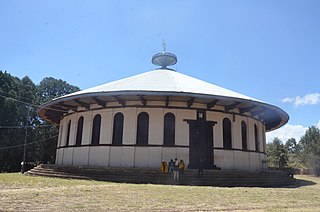
Tadbaba Maryam, also called Tadbaba Zion in ancient times, is an Ethiopian Orthodox Tewahedo church located in the place of Sayint in South Wollo, Amhara Region, Ethiopia. The current church bears the title in full "Head of Churches and Monasteries Tadbaba Maryam".
The persecution of the Ethiopian and Eritrean Orthodox Tewahedo Church has been surging over centuries. The church has encountered significant challenges throughout its history. Historically, notable persecutions attributed during Yodit Gudit era in 980, Ahmad ibn Ibrahim al-Ghazi invasion of Ethiopian Empire during the Ethiopian-Adal War (1529–1542) and the Italian occupation of Ethiopia (1936–1941). Still, the church faces significant persecutions where many Christians are killed by government forces and churches are burnt amidst political crisis. During the tension between Ethiopian Orthodox and the illegal Oromia synod, three people killed after unknown assailants opened fire in Shashamane in Oromia on 2 February 2023. According to witness, the Oromia police was the perpetrator of the attack. It is observed during Axum massacre in the Tigray War where 750 people reportedly killed in Axum Tsion feast day celebrated on 30 November.

